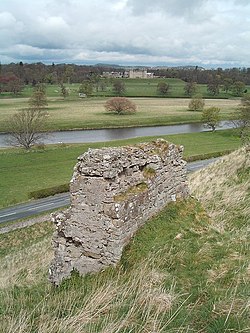Roxburgh Castle
- Not to be confused with Roxborough Castle
| Roxburgh Castle | |
| Roxburghshire | |
|---|---|
 The ruins of Roxburgh Castle, with Floors Castle behind | |
| Location | |
| Grid reference: | NT713337 |
| Location: | 55°35’47"N, 2°27’24"W |
| History | |
| Information | |
Roxburgh Castle is a ruined royal castle, overlooking the junction of the rivers Tweed and Teviot, in Roxburghshire, a county named after this once grand fortess and its attendant village now itself lost.
Roxburgh village grew up as a ‘castleton’ around the castle, and developed into the royal burgh of Roxburgh, which the army of King James II destroyed along with the castle after capturing it from its English garrison in 1460. Today the ruins stand in the grounds of Floors Castle, the seat of the Duke of Roxburghe, across the river from Kelso.
History
The castle was traditionally founded by King David I, and first recorded in c.1128 during his reign. In 1174 it was surrendered to England after the capture of William I of Scotland at Alnwick, and was often in English hands thereafter. The Scots made many attempts to regain the fortress.[1] On 19 February 1314 it was taken by Sir James Douglas (the "Black Douglas"), who supposedly disguised his men as cows, but was later lost again to the English.[2] While the Scots had control of the castle, they set about demolishing it, and in the words of the Lanercost Chronicle "all that beautiful castle the Scots pulled down to the ground, like the other castles that they had succeeded in capturing, lest the English should ever again rule the land by holding the castles."[3]
The castle was a base of operations for King Edward III of England during his 1334 winter campaign in Scotland. A siege in 1417 necessitated repairs. The Scots again besieged Roxburgh in 1460; in the course of the action King James II of Scotland was killed by shrapnel when one of his own cannons (known as a bombard) exploded. However Roxburgh was stormed, and James' queen, Mary of Guelders, had the castle demolished.[1][4]
In 1545, during the Rough Wooing, the English garrison commanded by Ralph Bulmer built a rectangular fort on the site at the instigation of the Earl of Hertford. This was destroyed in 1550 by the terms of the Treaty of Boulogne.[5]
The ruins of Roxburgh Castle stand in the grounds of Floors Castle, the seat of the Duke of Roxburghe.[6] These consist of a large mound, with very little stonework visible.
The 1314 capture of the castle is one of the inspirations of "The Three Perils of Man" by James Hogg.
Outside links
- RCAHMS record of Roxburgh Castle; Old Roxburgh Castle; Protector Somerset's Camp
- SCRAN File: Roxburgh Castle
References
- ↑ 1.0 1.1 Mike Salter (1985). Discovering Scottish Castles. Shire Publications Ltd. p. 17. ISBN 0-85263-749-7.
- ↑ RCAHMS record of Roxburgh Castle
- ↑ Howard Colvin; Brown, R. A. (1963), "The Royal Castles 1066–1485", The History of the King's Works. Volume II: The Middle Ages, London: Her Majesty's Stationery Office, p. 819
- ↑ Howard Colvin; Brown, R. A. (1963), "The Royal Castles 1066–1485", The History of the King's Works. Volume II: The Middle Ages, London: Her Majesty's Stationery Office, p. 820
- ↑ Mike Salter (1985). Discovering Scottish Castles. Shire Publications Ltd. p. 18. ISBN 0-85263-749-7.
- ↑ Coventry, Martin (2006). The Castles of Scotland. Birlinn. p. 561. ISBN 1-84158-449-5.